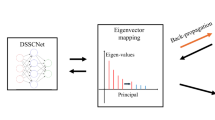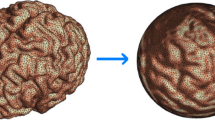Abstract
In the past few years, sparse representation based method has been used in many fields with breathtaking speed due to its superior sparse recovery performance. Sparse subspace clustering (SSC), as one of its application hot-spots, has attracted considerable attention. Traditional sparse subspace clustering methods employ the \(\ell _{1}\)-norm to induce sparse representation of data points. Typically, the use of \(\ell _{1}\)-regularization instead of the \(\ell _{0}\) one can make the objective function convex while it also causes large errors on large coefficients in some cases. In this work, we propose using the non-convex smoothed \(\ell _{0}\)-norm to replace the \(\ell _{0}\) one for affine subspace clustering. This leads to a non-convex minimization problem. We then propose an effective method to solve the problem which minimizes the objective function by using the gradient method and proximal projection. In addition, the proposed algorithm is robust to noise and can provide a fast solution. Extensive experiments on real datasets demonstrate the effectiveness of our proposed method.






Similar content being viewed by others
References
Basri R, Jacobs D (2003) Lambertian reflectance and linear subspaces. IEEE Trans Pattern Anal Mach Intell 25(2):218–233
Chen G, Lerman G (2009) Spectral curvature clustering (SCC). Int J Comput Vis 81(3):317–330
David A, Jean P (2002) Computer vision: a modern approach. Prentice Hall, Upper Saddle River, pp 654–659
Eftekhari A, Babaie-Zadeh M, Jutten C, Moghaddam HA (2009) Robust-SL0 for stable sparse representation in noisy settings. In: IEEE international conference on acoustics, speech and signal processing, ICASSP 2009. IEEE, pp 3433–3436
Elhamifar E, Vidal R (2013) Sparse subspace clustering: algorithm, theory, and applications. IEEE Trans Pattern Anal Mach Intell 35(11):2765–2781
Flusser J, Suk T (1993) Pattern recognition by affine moment invariants. Pattern Recognit 26(1):167–174
Gabay D, Mercier B (1976) A dual algorithm for the solution of nonlinear variational problems via finite element approximation. Comput Math Appl 2(1):17–40
Georghiades AS, Belhumeur PN (1998) Illumination cone models for faces recognition under variable lighting. In: Proceedings of CVPR 1998
Hong C, Yu J, Wan J, Tao D, Wang M (2015) Multimodal deep autoencoder for human pose recovery. IEEE Trans Image Process 24(12):5659–5670
Huang S, Yeh Y, Eguchi S (2009) Robust kernel principal component analysis. Neural Comput 21(11):3179–3213
Hull JJ (1994) A database for handwritten text recognition research. IEEE Trans Pattern Anal Mach Intell 16(5):550–554
Jolliffe I (2011) Principal component analysis. In: International encyclopedia of statistical science. Springer, Berlin, pp 1094–1096
Lee K, Ho J, Kriegman DJ (2005) Acquiring linear subspaces for face recognition under variable lighting. IEEE Trans Pattern Anal Mach Intell 5:684–698
Li C, Vidal R (2015) Structured sparse subspace clustering: a unified optimization framework. In: Proceedings of the IEEE conference on computer vision and pattern recognition, pp 277–286
Li J, Liang X, Shen S, Xu T, Feng J, Yan S (2018) Scale-aware fast r-cnn for pedestrian detection. IEEE Trans Multimed 20(4):985–996
Liu G, Lin Z, Yan S, Sun J, Yu Y, Ma Y (2013) Robust recovery of subspace structures by low-rank representation. IEEE Trans Pattern Anal Mach Intell 35(1):171–184
Lowe DG (1999) Object recognition from local scale-invariant features. In: The proceedings of the 7th IEEE international conference on Computer vision, 1999, 2:1150–1157. IEEE
Lu C, Min H, Zhao Z, Zhu L, Huang D, Yan S (2012) Robust and efficient subspace segmentation via least squares regression. In: European conference on computer vision. Springer, Berlin, pp 347–360
Martinez AM (1998) The AR face database. CVC Technical Report 24
Mohimani H, Babaie-Zadeh M, Jutten C (2009) A fast approach for overcomplete sparse decomposition based on smoothed \(\ell _{0}\) norm. IEEE Trans Signal Process 57(1):289–301
Nene SA, Nayar SK, Murase H et al (1996) Columbia object image library (coil-20)
Ng AY, Jordan MI, Weiss Y (2002) On spectral clustering: Analysis and an algorithm. In: Advances in neural information processing systems, pp 849–856
Siddiquie B, Feris RS, Davis LS (2011) Image ranking and retrieval based on multi-attribute queries. In: Proceedings of the IEEE conference on computer vision and pattern recognition, pp 801–808
Sonka M, Hlavac V, Boyle R (2014) Image processing, analysis, and machine vision. Cengage Learning
Tron R, Vidal R (2007) A benchmark for the comparison of 3-D motion segmentation algorithms. In: IEEE conference on computer vision and pattern recognition, 2007. IEEE, pp 1–8
Vidal R, Favaro P (2014) Low rank subspace clustering (LRSC). Pattern Recognit Lett 43:47–61
Wang J, Shi D, Cheng D, Zhang Y, Gao J (2016) LRSR: low-rank-sparse representation for subspace clustering. Neurocomputing 214:1026–1037
Wang Y, Xu H, Leng C (2013) Provable subspace clustering: When LRR meets SSC. In: Advances in Neural Information Processing Systems, pp 64–72
Wei L, Wang X, Wu A, Zhou R, Zhu C (2018) Robust subspace segmentation by self-representation constrained low-rank representation. Neural Process Lett 48(3):1671–1691
Wu Z, Yin M, Zhou Y, Fang X, Xie S (2017) Robust spectral subspace clustering based on least square regression. Neural Process Lett 48:1359–1372
Yan J, Pollefeys M (2006) A general framework for motion segmentation: independent, articulated, rigid, non-rigid, degenerate and non-degenerate. In: European conference on computer vision. Springer, Berlin, pp 94–106
Yang Y, Feng J, Jojic N, Yang J, Huang TS (2016) \(\ell _{0}\)-sparse subspace clustering. In: European conference on computer vision. Springer, Berlin, pp 731–747
You C, Robinson D, Vidal R (2016) Scalable sparse subspace clustering by orthogonal matching pursuit. In: Proceedings of the IEEE conference on computer vision and pattern recognition, pp 3918–3927
Yu J, Yang X, Gao F, Tao D (2017) Deep multimodal distance metric learning using click constraints for image ranking. IEEE Trans Cybern 47(12):4014–4024
Zhang J, Yu J, Tao D (2018) Local deep-feature alignment for unsupervised dimension reduction. IEEE Trans Image Process 27(5):2420–2432
Zhang Y (2010) Recent advances in alternating direction methods: Practice and theory. In: IPAM workshop on continuous optimization
Zheng X, Cai D, He X, Ma WY, Lin X (2004) Locality preserving clustering for image database. In: Proceedings of the 12th annual ACM international conference on Multimedia. ACM, pp 885–891
Zou H, Li R (2008) One-step sparse estimates in nonconcave penalized likelihood models. Ann Stat 36(4):1509
Acknowledgements
This paper is jointly supported by the 111 Project of Chinese Ministry of Education under Grant B12018 and the National Natural Science Foundation of China under Grant 61373055; 61672265.
Author information
Authors and Affiliations
Corresponding author
Additional information
Publisher's Note
Springer Nature remains neutral with regard to jurisdictional claims in published maps and institutional affiliations.
Rights and permissions
About this article
Cite this article
Dong, W., Wu, Xj. Robust Affine Subspace Clustering via Smoothed \(\ell _{0}\)-Norm. Neural Process Lett 50, 785–797 (2019). https://doi.org/10.1007/s11063-018-9962-x
Published:
Issue Date:
DOI: https://doi.org/10.1007/s11063-018-9962-x




